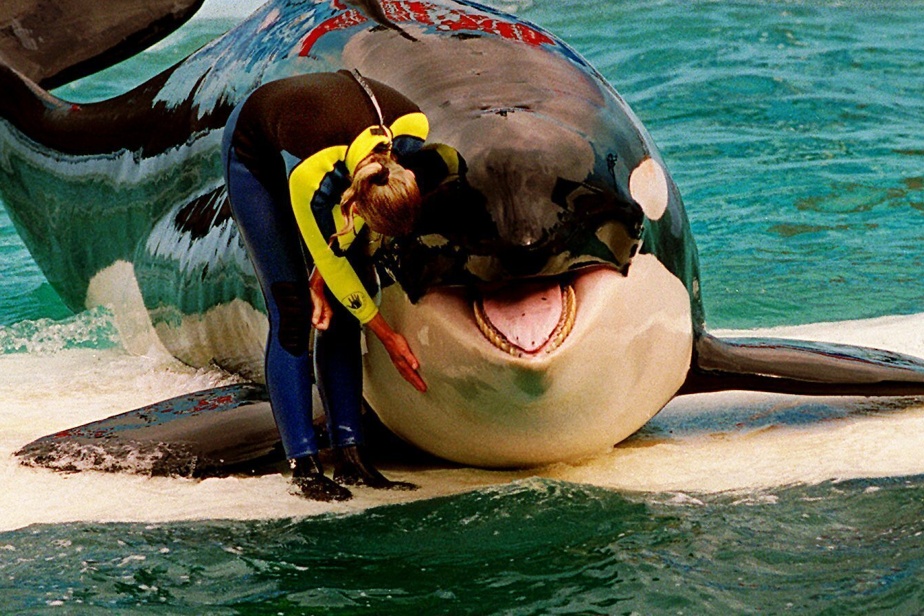(Miami) More than 50 years after the orca known as Lolita was captured for public display, plans are in place to return her from the Miami Seaquarium to her home waters in Northeast western Pacific, where an almost century-old, endangered killer whale still swims, believed to be its mother.
An unlikely coalition made up of the theme park owner, an animal rights group and an NFL philanthropist owner announced the deal at a press conference earlier this week.
“I’m thrilled to be part of Lolita’s journey to freedom,” Indianapolis Colts owner Jim Irsay said. I know Lolita wants to swim free again. »
Lolita, also known as Tokitae, was about four years old when she was captured in Puget Sound in the summer of 1970, at the time of the killer orca roundups. She spent decades performing to paying crowds before falling ill.
Last year, the Miami Seaquarium announced that it would no longer hold shows with her, per an agreement reached with federal regulators. Lolita, who is now 57 years old and weighs 2267 kg, currently lives in a pool 24 meters by 11 meters and 6 meters deep.
The orca that would be her mother, Ocean Sun, continues to swim freely with other members of their clan―known as the “L pod”―and is believed to be over 90 years old. Proponents of his release are therefore optimistic that Tokitae could still have a long life in the wild.
“This is a step towards restoring our natural environment, towards fixing what we have messed up with exploitation and development,” said Howard Garrett, chairman of the board of the advocacy group Orca Network, based on Whidbey Island, Washington. I think she’ll be excited and relieved to go home ― it’s her old neighborhood. »
The agreement concluded between Mr. Irsay; Eduardo Albor, who runs The Dolphin Company, the company that owns the Seaquarium; and Friends of Toki, co-founded by environmentalist Pritam Singh, still faces hurdles to gain government approval.
The transport time for the animal could be 18 to 24 months, according to the group, and the cost could amount to 20 million US.
Plans are to fly Lolita to an ocean sanctuary in the waters between Washington state and Canada, where she will first swim inside a large net while trainers and veterinarians teach him how to catch fish.
She’ll also need to build muscle, as killer whales typically swim 100 miles a day, said Raynell Morris, an elder from Washington’s Lummi Indian tribe who also sits on the Friends of Toki board. .
“She was four when she was captured, so she was learning to hunt. She knows her family’s song, Mr. Morris said. She will remember, but it will take time. »
The orca will be cared for around the clock until it acclimates to its new environment.
The people in charge of the Seaquarium are already preparing her for the trip.
The Dolphin Company took over ownership of the Seaquarium in 2021. The company operates some 27 other parks and habitats in Mexico, Argentina, the Caribbean and Italy.
The legacy of the whale roundups of the 1960s and 1970s continues to haunt a distinct group of endangered, salmon-eating orcas, known as the Southern Resident orcas, who spend most of their time in waters between Washington State and Canada.
At least 13 killer whales died in those roundups and 45 were delivered to amusement parks around the world, reducing Puget Sound’s resident population by about 40% and helping to cause inbreeding issues that persist to this day. today.
According to the Whale Research Center on San Juan Island, Washington, there are only 73 whales left in the southern resident population, which consists of three family groups called “pods.” This is only two animals more than in 1971.
Animal rights activists, including People for the Ethical Treatment of Animals, have long fought for Tokitae to spend her final years at home in a controlled environment.
Activists often demonstrate along the road that passes the Seaquarium. PETA says it doesn’t want Lolita to suffer the same fate as her companion Hugo, who died in 1980 of a brain aneurysm after repeatedly banging his head against the walls of his pelvis.
The Seaquarium opened in 1955 on Virginia Key, east of downtown Miami. It features a wide variety of creatures including dolphins, sea lions, manatees, reef fish, and sharks. It was used as a filming location for 88 episodes of the television series “Flipper”, as well as films in the 1960s.
